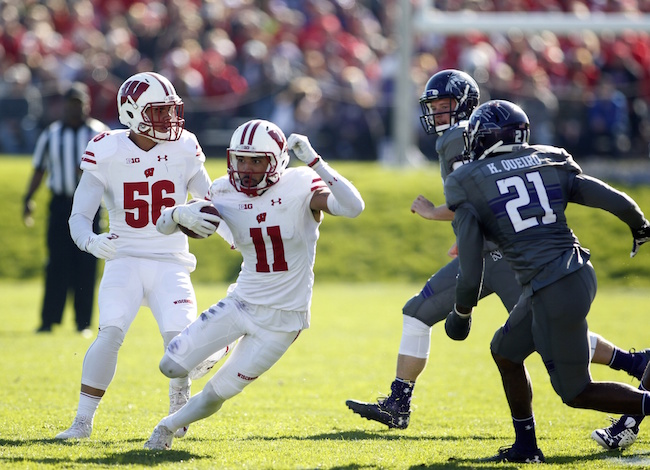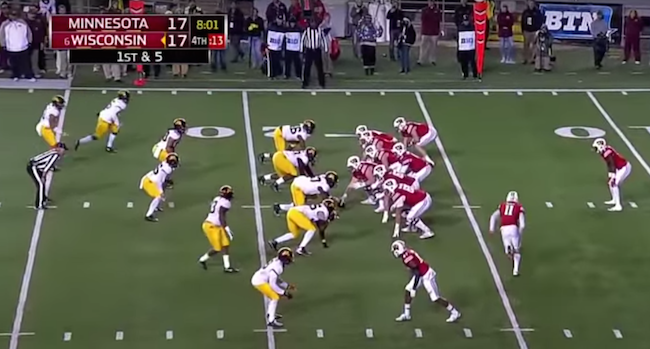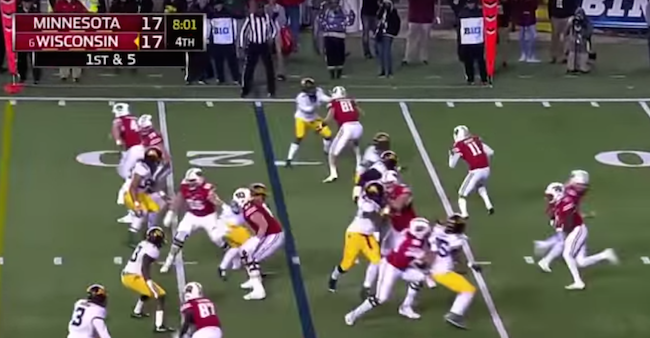Ad Disclosure
With the tap of Alex Hornibrook’s right foot, Jazz Peavy was gone.
Streaking behind the line of scrimmage, Peavy already had a head of steam by the time he got to the Wisconsin quarterback. As soon as Hornibrook made his first step back, Peavy was there waiting for the handoff. The Ohio State defensive end froze, determined not to be distracted by the wide receiver in motion. His eyes were still in the backfield, where Hornibrook faked a handoff to tailback Corey Clement.
By that point, it was too late. Peavy had already zoomed past the OSU defensive end. The only things he saw were green grass, his fullback and his tight end. Surely they could take on a linebacker and a cornerback. Peavy wasn’t even touched until a defensive back forced him out of bounds after a 12-yard gain.
First down, Wisconsin.
That sequence played out five times in the first half. Every Peavy jet sweep went for a first down. The Buckeye defense, loaded with future NFL players, allowed Peavy to rack up 67 yards on five first-half carries. That fueled a 10-point halftime lead for the Badgers against No. 2 Ohio State. Urban Meyer didn’t game-plan to stop Peavy on the jet sweep, and it showed.
In Meyer’s defense, Peavy had just four career carries before that mid-October game in 2016. He didn’t know that Wisconsin put that play in during fall camp, or that Peavy had been used as a rusher since his Pee Wee days. An adjustment had to be made at halftime.
The first time the Badgers ran Peavy on the jet sweep in the second half, Ohio State brought future All-American safety Malik Hooker down instead of having him defend against a possible deep pass. Peavy was popped by Hooker as soon as he tried to turn the corner. The adjustment was made, but the damage was done.
The “Jazz sweep” was born.
That nickname stuck with Peavy’s family, friends and teammates after his breakout running game against Ohio State.
Peavy finished the 2016 season with 21 carries for 318 yards as the Badgers’ new ace-in-the hole. Do some quick math and that breaks down to 15.1 yards per carry. Peavy’s runs resulted in a first down 11 times, including three sweeps that went for more than 45 yards. That was more than Clement had in a productive first-team All-B1G season.
If left unaccounted for, it wasn’t hard to figure out why Peavy gashed defenses running behind Wisconsin’s outside blockers.
“You get a good feel for what the running backs get on a daily basis,” Peavy told Saturday Tradition. “Guys are hustling to get on their blocks and secure their blocks and getting to the right place. When you’ve got things like that, it’s really easy to make big jets go to work.”
RELATED: Five B1G players that need to touch the rock more in 2017
The element of surprise certainly had something to do with the play’s emergence, at least against Ohio State. Wisconsin was and is known for having a dominant running game using a single back or an I-formation.
By the end of the season, however, it didn’t matter if teams accounted for the sweep. More times than not, they did.
“You could see from a mile away that it was coming,” fellow Wisconsin receiver Robert Wheelwright said. “But you had to stop it, and I feel like we had a bunch of individuals who worked together on that play. That was one of our best plays.
“We knew it was gonna hit each and every time they called it.”
In the fourth quarter of the regular-season finale, Minnesota was ready for the Jazz sweep. As soon as Peavy went in motion, the Gophers brought the safety within four yards of the line scrimmage. He appeared to have the play sniffed out, and he looked ready to stop Peavy for a loss.
Well, that was until he was wiped clean by Wisconsin tight end Troy Fumagalli.
A mere 71 yards later, Peavy was finally brought down by the Minnesota secondary.

That play set up Wisconsin’s go-ahead touchdown, which was enough to keep Paul Bunyan’s Axe in Madison and keep the Badgers’ College Football Playoff hopes alive.
Long runs like that made the Jazz sweep adrenaline-pumping, must-see TV in 2016.
“As soon as I hear it’s called,” Peavy said, “I’m licking my chops, my heart’s racing and I’m thinking of any situation that can pop up when I get the ball.”
With the play established as a key part of Wisconsin’s offense, Peavy could see some different looks in 2017. Defensive coordinators could rotate more defenders down and sell out to prevent him from turning the corner.
RELATED: Don’t be surprised if the B1G boasts America’s top two tight ends in 2017
Wisconsin coaches expect that to happen. But that also means the Kenosha, Wis. native will cause a stir whenever he goes in motion, which should create more holes for Badger tailbacks, and it could prevent a safety from helping on a deep pass. Like a running back on a typical play-action pass, Peavy has to sell the fake.
“My coaches are always warning me that when we run the phonies now, I’ve got to make sure it looks just like the jet sweeps because everyone’s gonna to start keying on to it and they’re gonna bring more guys to it,” he said. “They tell me to just do whatever I can to draw attention to myself. Running all the actual jets in the previous game just helps open up for those phonies and make other plays go.”
It’s easy to forget that while the Jazz sweep emerged, Peavy also emerged as Wisconsin’s leading receiver in 2016. His 635 receiving yards and five receiving touchdowns were major improvements after he flashed potential — but not as a rusher — during his sophomore season.
Before last year, Peavy’s biggest moment at Wisconsin wasn’t even a catch. Well, that depends on who you ask. The officials from the late-November game vs. Northwestern in 2015 overruled what would’ve been a go-ahead score and Peavy’s first career touchdown. You can be the judge of that.
But Peavy’s role expanded greatly in the 16 months since that infamous play. He’s no longer the underclassman buried on the depth chart. Heading into 2017, Peavy is the Badgers’ versatile No. 1 receiver. He’ll take on an even bigger workload with Wheelwright gone.
RELATED: Game manager? Why Alex Hornibrook can be so much more for Wisconsin
“He can be very great,” Wheelwright said of Peavy. “With this offense, it’s set up for him. He’s still gonna have those sweeps, he’s still gonna be able to catch the ball…I feel like we have a lot of playmakers around him so they can’t just focus on him. He’s gonna have a great season.”
In case Peavy didn’t have enough responsibility on his plate, his offseason to-do list is long. Much like the guys that pave the way for his long runs, Peavy is working to improve as a blocker. He also wants to become a consistent third-down target for Hornibrook.
“If I can do that,” Peavy said, “everything else will fall into place.”
As far as the Jazz sweep is concerned, Peavy noticed some improvements he could make to take that part of his game to the next level. Recognizing the cutback lane — like he did during his 46-yard touchdown run against Northwestern last year — should yield more scores in 2017.

Peavy and the Badgers still have five months to make tweaks before the 2017 season opener. It’ll be a little different than last year when they spent all offseason gearing up for No. 5 LSU at Lambeau Field to kick off the season. This year, the Badgers will host a Utah State squad that went 3-9 in the Mountain West in 2016.
The game won’t have quite the same buildup, but a Jazz sweep on the first play from scrimmage would certainly get Camp Randall Stadium buzzing.
“Oh I hope so,” Peavy said. “That’d be a nice way to open up the season.”
Utah State might not think so.
Connor O'Gara is the senior national columnist for Saturday Tradition. He's a member of the Football Writers Association of America. After spending his entire life living in B1G country, he moved to the South in 2015.



